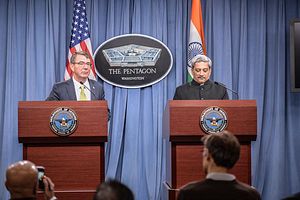Defense ties between the United States and India have taken another small step toward consolidation with the recent visit of the U.S. Secretary of Defense Ashton Carter to India. The two countries finally managed to agree “in principle” on a logistics agreement, which could be finalized in weeks. The agreement is expected to help the two militaries coordinate better, including in exercises, and also allow the United States to more easily sell fuel or provide spare parts to the Indians. A second pact to improve the sharing of information on commercial shipping, in a move to beef up security on the seas, is also close to realization. There has been, however, no real progress on the joint development of jet engines and aircraft carrier technologies.
These are good times for U.S.-India defense ties. Carter himself has had a long standing interest in India and in strengthening closer ties between the two countries. This was his third visit to India since assuming office in 2015. He was a strong supporter of the landmark U.S.-India nuclear deal in the Bush years and, as deputy secretary of defense in 2011, he was the principal architect of the Defense Trade and Technology Initiative (DTTI) to help the flow of advanced U.S. technology to India, a key Indian priority once strongly resisted by Washington’s defense bureaucracy. He has taken this forward with the setting up of the India Rapid Reaction Cell (IRRC), the only country-specific cell in the Department of Defense, as part of the DTTI to fast-forward India-related defense acquisition issues. Carter has emphasized the Pentagon’s “decision to change its mind-set regarding technology transfer to India from a culture of ‘presumptive no’ to one of ‘presumptive yes’” in the context of the United States’ changing strategic priorities in the Indo-Pacific.
Carter came to India at a time when the U.S.-India Defense Technology and Partnership Act is being considered by the U.S. Congress, which, if passed, would encourage the U.S. president “to coordinate with India on an annual basis to develop military contingency plans for addressing threats to mutual security interests of both countries.” It also calls for the development of “strategic operational capabilities,” which will give the two states “the ability to execute military operations of mutual security interest while sustaining minimal damages and casualties, through the use of military means, possessed in sufficient quantity, including weapons, command, control, communication, intelligence, surveillance, and reconnaissance capabilities.” Today, India is interested in co-development opportunities more than simply buying U.S.-made weapons, especially with the government pushing its ‘Make in India’ initiative.
Though many in India worry that the United States wants to make New Delhi a junior partner in its regional alliance network in Asia, Carter has given clear indications that he understands Indian concerns regarding strategic autonomy. He has been explicit that India was not likely to be an exclusive partner of the United States:
Indians are, like many others, also proud. So they want to do things independently, and they want to do things their own way. They don’t want to do things just with us. They want to do things with all that’s fine. So we’re not looking for anything exclusive. But we are looking for as close a relationship and a stronger relationship as we can because it’s geopolitically grounded.
This geopolitical grounding is provided by the rise of China and all that means for Indian strategic interests. India has reached out to China recently with its national security advisor and the defense minister both visiting the country. But China has shown no signs that it is willing to change or even moderate its anti-India posture. Insisting that designation of any individual as terrorist by the United Nations is a “serious issue,” China recently blocked the UN from banning Jaish-e-Mohammad chief and the recent Pathankot terror attack mastermind, Masood Azhar, under Security Council Resolution 1267.
To counter the China challenge, the United States wants to build a “network” of countries with “shared values, habits of cooperation, and compatible and complementary capabilities,” which will expand the strategic reach of the participating countries, enable them to pool their resources to share the security burden, and, thereby, “help ensure the peace and stability in the region for years to come.” New Delhi need not become part of this network, but it needs to articulate the need for a new security architecture in Asia that can successfully take on the challenge posed by a rising and aggressive China.
India and the United States have thus been striving to conclude a series of so-called “foundational agreements” for years now and, under the UPA, even the least controversial, the logistics supply agreement, could not move forward as then-Defense Minister A.K. Antony, under the influence of left-wing parties, became convinced about malign U.S. motives in pushing it through. With the declaration that the logistics agreement has been finalized as of Carter’s visit, the United States and India can now move forward with some confidence about the future their defense ties. India is in the big leagues today and it should start thinking big. The old Third World rhetoric doesn’t do justice to India’s 21st century global aspirations. The Modi government is gradually shedding Indian strategic diffidence, but it needs to move faster if India is to avail of the opportunities that present themselves today.

































